|
abot84-12
|

|
George Ledyard Stebbins, Jr.
|
copyright: -
license: http://images.botany.org/index.html#license |
Image
|
Historical Botany

|

|
|
abot84-2
|
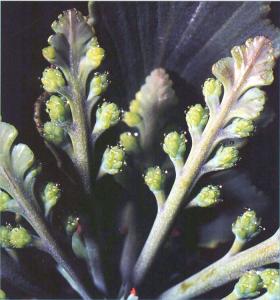
|
Pyllocladus glaucus Carr. (Phyllocladaceaes), Toatoa or Blue Celery Pine, endemic to New Zealand, showing part of a pseudowhorl of fertile phylloclades. Cones are borne marginally towards the base of these modified branch complexes. The individual ovules with pollination drops are at the stage of pollen receptivity. Magnification x5, from a color transparency by J. E. Braggins.
|
copyright: -
license: http://images.botany.org/index.html#license |
Image
|
Reproductive Biology

|

|
|
abot84-3
|
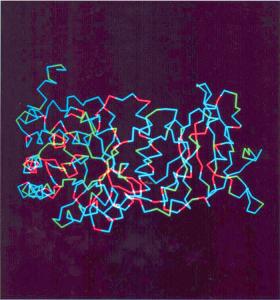
|
Alpha carbon backbone of the large subunit of ribulose-1,5-bisphosphate carboxylase/oxygenase, color coded to show residues conserved throughout the 300 million years of evolution of the seed plants. Absolutely conserved residues in red, residues with one substitution in green, and variable sites in blue.
|
copyright: -
license: http://images.botany.org/index.html#license |
Image
|
Structure and Development

|

|
|
abot84-4
|
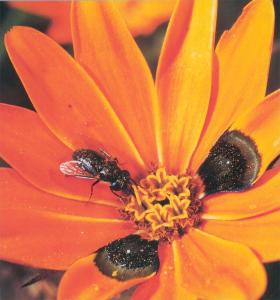
|
A capitulum of the South African "beetle daisy" (Gorteria diffusa: Asteraceae). The dark raised spots on the ray florets are strikingly similar to the bee-fly (Megapalpus nitidus: Bombyliidae) that pollinates this plant. Experiments show that bee-flies are more strongly attracted to capitula with spots than capitula in which spots have been removed.
|
copyright: -
license: http://images.botany.org/index.html#license |
Image
|
Reproductive Biology

|

|
|
abot84-5
|
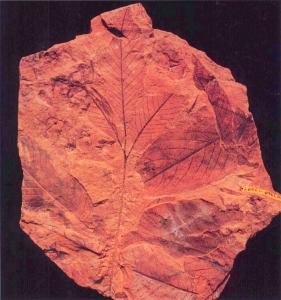
|
A compound leaf and scattered wing nuts of Polyptera manningii Manchester et Dilcher (extinct Juglandaceae) in siltstone from the paleocene of southwestern Wyoming. Width of the specimen is 15 cm.
|
copyright: -
license: http://images.botany.org/index.html#license |
Image
|
Systematics

|

|
|
abot84-6
|
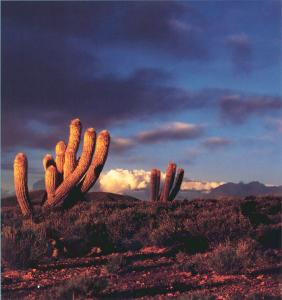
|
Plants of Oreocereus celsianus growing in the altiplano of northern Argentina at an altitude of 4000 m. These cacti have dimorphic wood. While young and small they produce a soft spongy wood and the body is supported by turgor. When older, taller, and heavier they produce a fibrous wood strong wnough to support the body.
|
copyright: -
license: http://images.botany.org/index.html#license |
Image
|
Ecology

|

|
|
abot84-6a
|
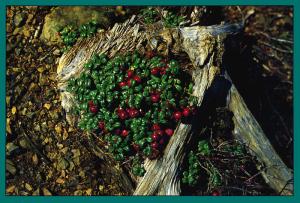
|
Vaccinium vitis-idaea L. growing on the ultramafic rock of Mt. Albert, Gasp
|
copyright: -
license: http://images.botany.org/index.html#license |
Image
|
Ecology

|

|
|
abot84-7
|
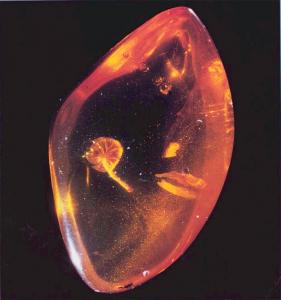
|
Protomycena electra Hibbett, Grimaldi, & Donoghue gen. et sp. nov. (Fungi Basidiomycota). This mushroom was found in Dominican amber and is ~15-30 million years old. It is remarkable not only for its exquisite preservation, but also for its striking morphological resemblance to extant mushrooms in Mycena and other Tricholomataceae. Protomycena is one of only three known fossil mushrooms.
|
copyright: -
license: http://images.botany.org/index.html#license |
Image
|
Paleomycology and Paleobotany

|

|
|
abot84-8
|
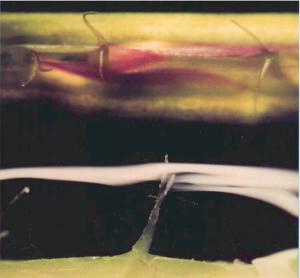
|
Flow visualizations (rose bengal dye in top view; milk in bottom view) around three carpellate flowers of Zostera marina in a flow chamber at an ambient velocity of ~2 cm/s.
|
copyright: -
license: http://images.botany.org/index.html#license |
Image
|
Reproductive Biology

|

|
|
abot84-9
|
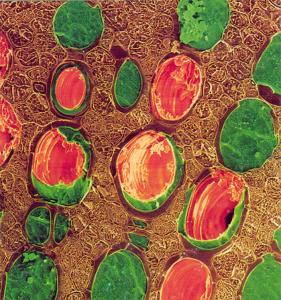
|
Vessel contents in the petiole of a transpiring sunflower leaf. Vessels containing water shown in green, gas spaces (embolisms) in red. Some vessels are completely embolized, others contain varying amounts of water as well as gas. The proportion of embolized vessels was followed during a day's transpiration. Petioles were snap-frozen intact on the transpiring plant, and viewed, still frozen, in the cryo-scanning microscope.
|
copyright: -
license: http://images.botany.org/index.html#license |
Image
|
Physiology and Development

|

|
|
abot85-1
|
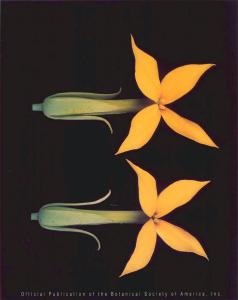
|
The yellow, fourmerous, tubular flowers of Kalanchoe marmorata from Central East Africa illustrate two aspects of convergent evolution in Crassulaceae: sympetaly and variation in number of floral parts (either a reduction or increase).
|
copyright: BSA,
license: http://images.botany.org/index.html#license |
Image
|
Systematics

|

|
|
abot85-10
|
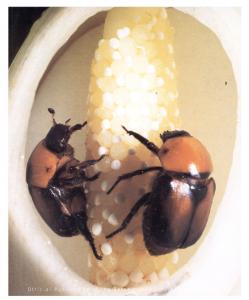
|
Beetles are important pollinators in a lowland dipterocarp forest in Southeast Asia. Most of canopy and emergent dipterocarps are pollinated by beetles feeding on floral tissues. Some understory trees and forest floor herbs are pollinated by different types of beetles. Homalomena propinqua (Araceae) is pollinated by two specias of beetles. One of them, Parastasia sp. (Scarabaeidae), stays inside the spathe chamber and feeds on staminodes.
|
copyright: BSA,
license: http://images.botany.org/index.html#license |
Image
|
Tropical Biology

|

|
|
abot85-11
|
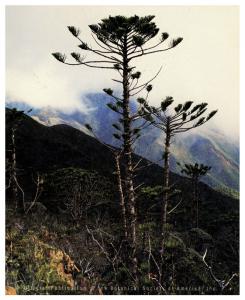
|
Araucaria humboldtensis (Araucariaceae) on the southern slope of Mt. Humboldt, New Caledonia. New Caledonia possesses 13 endemics of Araucaria, and they form a monophyletic group with very low differentiation in rbcL sequences.
|
copyright: BSA,
license: http://images.botany.org/index.html#license |
Image
|
Systematics

|

|
|
abot85-12
|
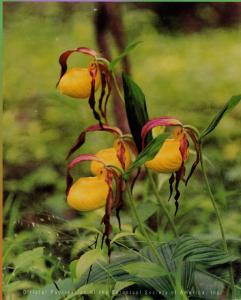
|
Lady's slippers from a disjunt population of the rare Cypripedium kentuckiense in Eastern Virginia.
|
copyright: BSA,
license: http://images.botany.org/index.html#license |
Image
|
Systematics

|

|
|
abot85-2
|
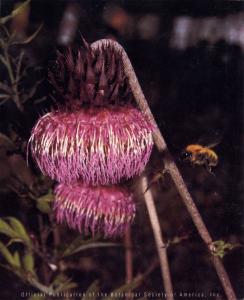
|
A flowering head of Cirsium pupuratum and a nectar-foraging bumble
bee, Bombu honshuensis.
|
copyright: BSA,
license: http://images.botany.org/index.html#license |
Image
|
Systematics

|

|
|
abot85-3
|
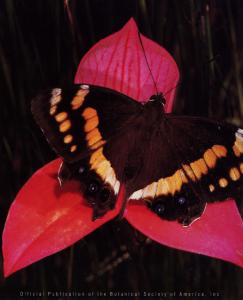
|
Flowers of the orchid Disa uniflora are pollinated exclusively by the Mountain Pride butterfly (Meneris tulbaghia: Salyrinae). The genus Disa has undergone spectacular adaptive radiation in southern Africa. Phylogenetic analysis shows that shifts from one pollination system to another have been a major feature of evolutionary diversification in this genus.
|
copyright: BSA,
license: http://images.botany.org/index.html#license |
Image
|
Unclassified

|

|
|
abot85-4
|
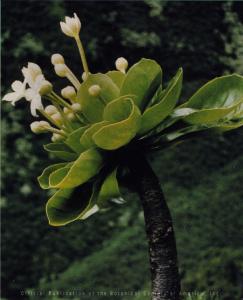
|
Brighamia rockii (Campanulaceae) in full flower at ka'aloa Peak, Moloka'i, Hawaii. Both members of this endemic Hawaiian genus, B. rockii rom Moloka'i and its sister species B. insignis from Kaua'i and Ni'ihau, are federally endangered.
|
copyright: BSA,
license: http://images.botany.org/index.html#license |
Image
|
Population Biology

|

|
|
abot85-5
|
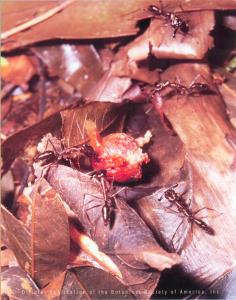
|
Arillate seeds of Cabralea canjerana (Meliaceae) are primarily disperesed by birds in the Atlantic forest of Brazil. However, hundereds of naturally fallen or partially eaten diaspores may be found on the forest floor with bits of aril attached. The red lipid-rich aril is highly attractive to ants, such as the large Odontomachus chelifer (size ~ 2cm). Aril removal by ants greatly facilitates seed germination.
|
copyright: BSA,
license: http://images.botany.org/index.html#license |
Image
|
Ecology

|

|
|
abot85-6
|
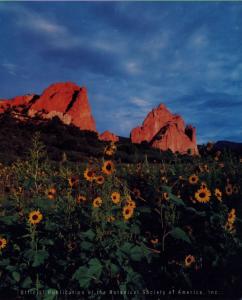
|
The common sunflower, Helianthus annus L., from the Garden of the
Gods in Colorado Springs, Colorado.
|
copyright: BSA,
license: http://images.botany.org/index.html#license |
Image
|
Reproductive Biology

|

|
|
abot85-6a
|
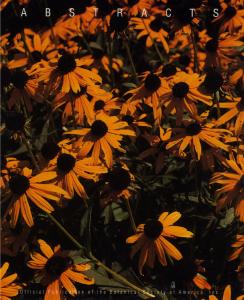
|
Black-eyed Susan, one of the many cultivators of Rudbeckia hirta L., the state flower of Maryland.
|
copyright: -
license: http://images.botany.org/index.html#license |
Image
|
Unclassified

|

|